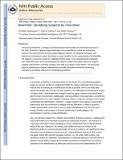BrainPrint: Identifying Subjects by Their Brain
Author(s)
Wachinger, Christian; Golland, Polina; Reuter, Martin
DownloadGolland_Brainprint.pdf (565.3Kb)
OPEN_ACCESS_POLICY
Open Access Policy
Creative Commons Attribution-Noncommercial-Share Alike
Terms of use
Metadata
Show full item recordAbstract
Introducing BrainPrint, a compact and discriminative representation of anatomical structures in the brain. BrainPrint captures shape information of an ensemble of cortical and subcortical structures by solving the 2D and 3D Laplace-Beltrami operator on triangular (boundary) and tetrahedral (volumetric) meshes. We derive a robust classifier for this representation that identifies the subject in a new scan, based on a database of brain scans. In an example dataset containing over 3000 MRI scans, we show that BrainPrint captures unique information about the subject’s anatomy and permits to correctly classify a scan with an accuracy of over 99.8%. All processing steps for obtaining the compact representation are fully automated making this processing framework particularly attractive for handling large datasets.
Date issued
2014Department
Massachusetts Institute of Technology. Computer Science and Artificial Intelligence Laboratory; Massachusetts Institute of Technology. Department of Electrical Engineering and Computer ScienceJournal
Medical Image Computing and Computer-Assisted Intervention – MICCAI 2014
Publisher
Springer-Verlag
Citation
Wachinger, Christian, Polina Golland, and Martin Reuter. “BrainPrint : Identifying Subjects by Their Brain.” Lecture Notes in Computer Science (2014): 41–48.
Version: Author's final manuscript
ISBN
978-3-319-10442-3
978-3-319-10443-0
ISSN
0302-9743
1611-3349